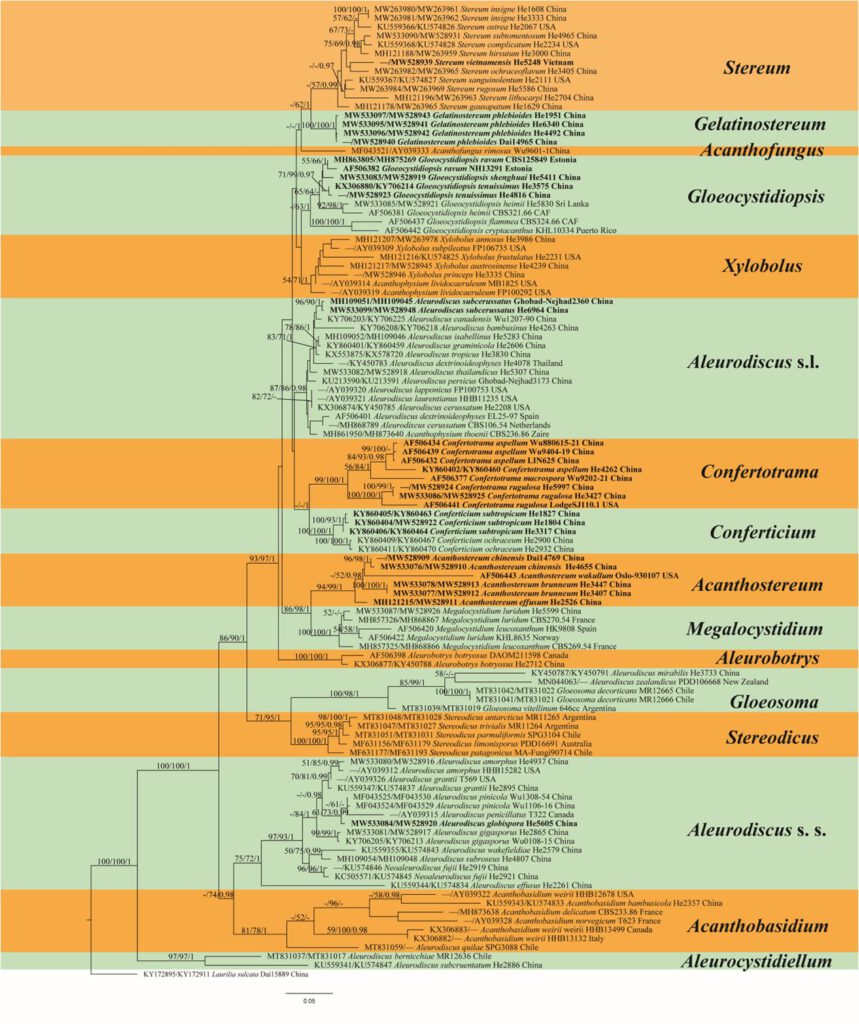Gelatinostereum S.H. He, S.L. Liu & Y.C. Dai, gen. nov.
MycoBank number: MB; IndexFungorum number: IF; Facesoffungi number: FoF 10781;
(Descriptions of sexual and asexual states of the genus)
Sexual state: Fruiting body – Basidiomata annual, resupinate to effused-reflexed, adnate, separable, gelatinous, hygrophanous, soft when fresh, becoming ceraceous to cartilaginous, brittle after dry. Pilei small, oftern radiately plicate, with abhymenial surface glabrous, light brown, golden brown to dark brown, indistinctly zonate and sulcate. Hymenophore smooth, tuberculate to merulioid, greyish orange, brownish orange, light brown to brown, uncracked or densely cracked with age; margin determinate, abrupt, adnate or slight elevated and curved toward hymenophore, white when juvenile, slightly paler or concolorous with hymenophore when mature. Context brownish orange, with a compact and agglutinated texture.
Microscopic structures – Hyphal system dimitic. Generative hyphae simple-septate, colorless, thin- to thick-walled with a wide lumen, smooth, rarely branched, moderately septate. Skeletal hyphae colorless, distinctly thick-walled, smooth, unbranched, not septate, with walls swelling in KOH. Gloeocystidia numerous, tubular, subclavate or subulate, colorless, thin-walled, smooth, often with liquid contents, embedded. Hyphidia numerous, unbranched, colorless, thin- to slightly thick-walled, smooth. Basidia clavate, colorless, thin-walled, smooth, with four sterigmata and a basal septum. Basidiospores cylindrical to suballantoid, colorless, thin-walled, smooth, amyloid, acyanophilous.
Asexual state: not observed.
Type species: Gelatinostereum phlebioides S.H. He, S.L. Liu & Y.C. Dai
Notes: Gelatinostereum is similar to Stereum by sharing the effused-reflexed basidiomata, a dimitic hyphal system with simple-septate generative hyphae and smooth amyloid basidiospores but differs in having gelatinous and brittle basidiomata with a smooth to merulioid hymenophore and thickened subhymenium, thin-walled gloeocystidia and numerous hyphidia. In the phylogenetic tree, Gelatinostereum formed a sister lineage to Stereum, but their relationship was not strongly supported by MP and ML analyses (Fig. 1).
Importance and role:
Importance of genus to humans or ecosystem Not found
Industrial relevance and applications Not found
Quarantine significance Not found
Biochemical importance of the genus, chemical diversity or applications Not found
Species list
Gelatinostereum phlebioides S.H. He, S.L. Liu & Y.C. Dai, sp. nov.
Phylogenetic placement of genus Gelatinostereum

Fig. 1. Phylogenetic tree obtained from maximum parsimony analysis of ITS and nrLSU sequence data of Stereaceae. Branches are labelled with parsimony bootstrap values (≥ 50%, front), likelihood bootstrap values (≥ 50%, middle) and Bayesian posterior probabilities (≥ 0.95, back). New taxa are shown in bold.
Species
